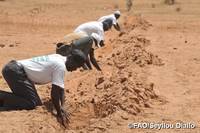Management of Sandy Soils
Sandy soils are those that are generally coarse textured until 50 cm depth and consequently retain few nutrients and have a low water holding capacity.
Soil management practices which lead to an increase in the fine fraction are helpful in improving soil properties and crop productivity.
- Fertilization of these soils is considered essential. Inorganic fertilization is the main practice.
- Application of organic manures can supply nutrients in slowly available forms and improve soil physico–chemical properties.
- Surface application of organic manures to sandy soils does not last so the manure should be dug deeper into the soil or a carpet-like layer spread of not less than one centimeter thick, which will improve water storage, biological activity, nutrient status and increase yields.
- Mulch can be added to improved water storage by reducing evaporation. Crop residues, on the surface of the soil reduce evaporation losses, decrease the range between maximum and minimum soil temperature, and reduce wind erosion.
- For tillage to be really effective, it has to be done at the earliest possible time after irrigation or rainfall when the evaporation rate is still high.
- Minimum tillage, maintenance of a cover crop, strip cropping, crop rotations, control of grazing and establishment of shelter belts and windbreaks are some of the protective measures to counter the high susceptibility of sandy soils to erosion.
- Besides the conventional dry vegetation method, use of artificial surface sealants such as petroleum, synthetic rubber, chemicals and water soluble plastics have also been adopted for dune and drift sand stabilization.
- Afforestation with selected trees and shrubs is a complementary measure that should follow stabilization of dunes.
- Overgrazing on coarse textured soils must be avoided. The introduction of rotational grazing helps to combat this hazard. It might be better not to permit grazing but to use fodder cut on feeding lots.

